目录:
后台开发必备知识,不过我不是搞这个的,只是因为很久以前就想写这些东西,事情多,拖到现在。写的过程里面发现很多问题,不会全部说,最后会顺带提一提。
注意,本篇笔记只是对接口写法做了记录,并没有进行更严格的设计和限制,包括更严密的封装,这里只是学习它实现的原理。
不过有些idea还是要知道的,系统定时对缓存进行清除并加入满足条件的新数据,是根据:访问时间,访问次数,可用缓存容量(分配到的内存)等因素决定的,实际设计其实很多东西需要考虑。
一、介绍:
LRU,Least Recently Used,最近最少使用,服务器缓存常用算法的一种。
比如说一些系统登录的操作,不可能每次你访问系统都去调用数据库的东西,如果能划出一些空间来,比如说500M,用来缓存这些东西,这样用户访问的时候先在缓存里找,找不到,再去访问数据库,同时把被访问的内容放到缓存里面(我们可以假设这些东西还会经常被访问)。然而,我们分配用来做缓存(Cache)的空间肯定是有限的,总不可能从数据库读的东西全部放到缓存里,所以,当缓存里的内容达到上限值的时候,我们就要把最少使用的东西写回数据库,再将新的访问内容从数据库暂存到缓存里面。
二、数据结构:
最常用的数据结构实现方式是hash_map和Double-Linked List,hash_map只是为了实现键值key-value对应,这样就避免了每次寻找特定值都要在双线链表里面顺序查找,服务器是没办法负担这种低效率的查找方法的。
我们可以为链表节点写一个结构体,用来定义节点的类型;然后专门写一个类用来组织缓存信息的存放——以双链表的形式。
template<class K, class T> struct Node { K key; T data; Node *next; Node *prev; };
template<class K,class T> class LRUCache { public: LRUCache(size_t size); //typedef unsigned int size_t ~LRUCache(); void Put(K key,T data); T Get(K key); private: void Attach(Node<K,T>* node); void Detach(Node<K,T>* node); private: hash_map<K,Node<K,T>*> hashmap; vector<Node<K,T>*> linkedList; Node<K,T>* head; Node<K,T>* tail; Node<K,T>* entries; //temp nodes };
看代码太枯燥,我画了个UML图:
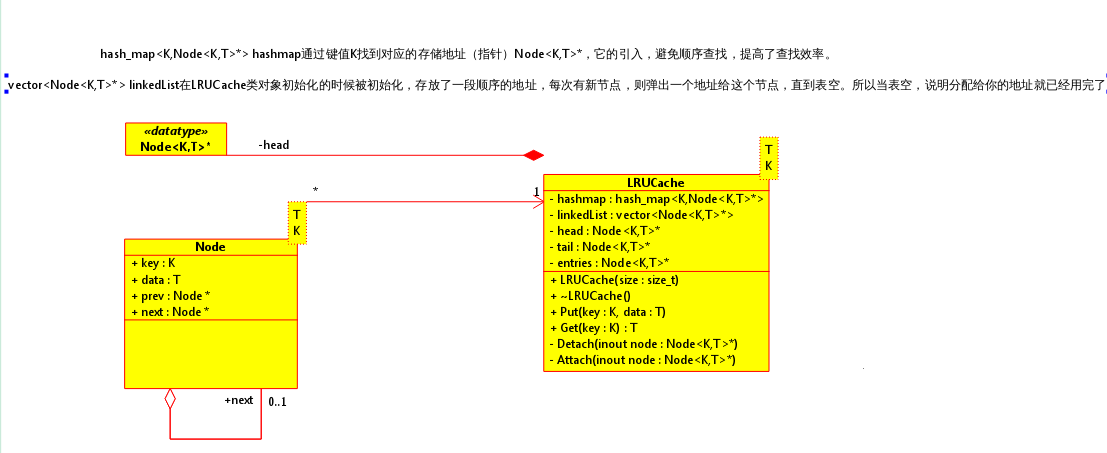
三、主要的两个函数接口Put()和Get():
最基本的,不是存,就是取。那修改呢?合并到存里面去了,通过键值key查找一个hash_map对应的value,如果value不是NULL,那么更新value的内容即可。其实服务器缓存比较多作的是读多写少的东西。
因为代码实在是太枯燥了,所以针对Put函数和Get函数画了两张流程图:
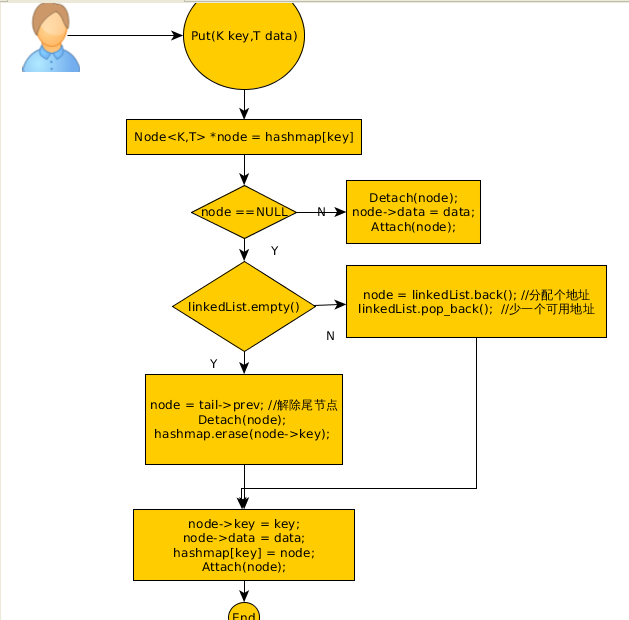
其中,Detach(node)表示将这个节点从双链表中解出,成为一个独立的节点;Attach(node)表示将node插入到头节点head后面(表示它可能再次被用到),这样的话,如果自己再设计一个GetFirst()函数,就能直接获取上次的访问结果,这种访问连hash_map都不需要用到。
流程讲解:
在上述Put函数流程图中,注意第一个判断“node==NULL”,这个node地址是通过hashmap映射而来的:1、如果不是NULL,说明这个节点已经存在,那么将该节点的数据data重写以后加到链表头;
2、如果是NULL,还要进行第二个判断“分配地址的linkedList是不是已经空了”:
2.1、如果空了,说明全部可用地址已经分配完了,那么,将原链表的最后一个节点踢出链表(应写入数据库),然后将被踢出点的hashmap中对应的key-value擦除,然后再加入新节点,并在hashmap中对应好新节点的key-value;
2.2、如果不空,那么从linkedList中分配个新地址给这个节点,同时linkedList要弹出分配完的地址,然后再将新节点加入链表中,对应好hashmap中的key-value。
要注意,hashmap用来对应key-value,这里是方便查找;而vector变量linkedList也只是在初始化的时候存储了一块连续地址,用来分配地址,它们两者都不是用来直接构建链表的,链表是你自己建立的。
Get()函数就比较简单了:
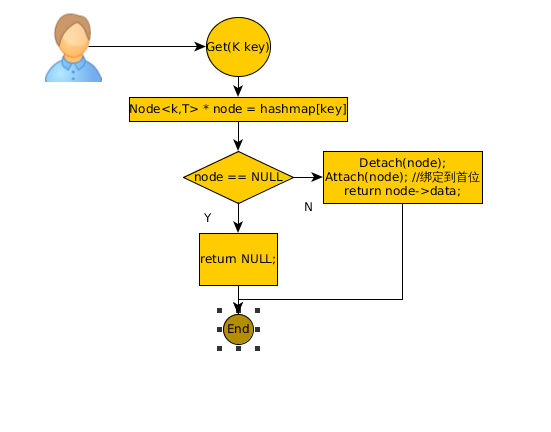
四、C++代码实现:
代码不是我原创的(后面给出原文地址),不过理清思路之后我自己实现了一遍,测试的过程实在是各种奇葩和辛苦(因为一个不注意的小地方)。
代码实现里用到了hash_map,注意,这个不是C++标准的一部分,所以你要自己去库文件里找找,一般来说库文件都是在/usr/include下面的了,cd到这个文件夹,然后用grep找一下:
cd /usr/include
grep -R "hash_map"
最后你会发现是这个头文件:<ext/hash_map>,用文本文档打开来看一下,因为是限制了命名空间的,会发现有两个可用的命名空间,其中一个是__gnu_cxx。
代码我一开始是用Qt写的,不过后来发现Qt没法调试(后面再说),于是最后使用Eclipse完成了调试和测试,下面先给出代码:

1 #include <iostream> 2 #include<ext/hash_map> 3 #include<vector> 4 #include<assert.h> 5 #include<string> 6 #include<stdlib.h> 7 #include<stdio.h> 8 #include<iomanip> 9 using namespace std; 10 //grep -R "hash_map" /usr/include . Find the file and you will know what the namespace is. 11 using namespace __gnu_cxx; 12 13 14 template<class K, class T> 15 struct Node 16 { 17 K key; 18 T data; 19 Node *next; 20 Node *prev; 21 }; 22 23 template<class K,class T> 24 class LRUCache 25 { 26 public: 27 LRUCache(size_t size) //typedef unsigned int size_t 28 { 29 entries = new Node<K,T>[size]; 30 assert(entries!=NULL); 31 for(int i = 0; i < size; i++) 32 { 33 linkedList.push_back(entries+i); //Store the addr. 34 } 35 //Initial the double linklist 36 head = new Node<K,T>; 37 tail = new Node<K,T>; 38 head->prev = NULL; 39 head->next = tail; 40 tail->next = NULL; 41 tail->prev = head; 42 } 43 ~LRUCache() 44 { 45 delete head; 46 delete tail; 47 delete []entries; 48 } 49 void Put(K key,T data) 50 { 51 Node<K,T> *node = hashmap[key]; 52 if(node == NULL) //node == NULL means it doesn't exist 53 { 54 if(linkedList.empty()) //linkedList is empty means all avaliable space have been allocated 55 { 56 node = tail->prev; //Detach the last code 57 Detach(node); 58 hashmap.erase(node->key); 59 } 60 else 61 { 62 node = linkedList.back(); //Allocate an addr to the node 63 linkedList.pop_back(); //Pop the addr mentioned above 64 } 65 node->key = key; 66 node->data = data; 67 hashmap[key] = node; 68 Attach(node); 69 } 70 else 71 { 72 Detach(node); 73 node->data = data; 74 Attach(node); 75 } 76 } 77 78 T Get(K key) 79 { 80 Node<K,T> * node = hashmap[key]; 81 if(node) 82 { 83 Detach(node); 84 Attach(node); //Attach the node to the fisrt place 85 return node->data; 86 } 87 else 88 { 89 return T(); 90 /*U can write some codes to test it: 91 *void main() 92 *{ 93 *char c = int(); 94 cout<<c<<endl; 95 int i = char(); 96 cout<<i<<endl; 97 cout<<char()<<endl; 98 cout<<int()<<endl; 99 }*/ 100 } 101 } 102 private: 103 void Attach(Node<K,T>* node) 104 { 105 assert(node != NULL); 106 node->next = head->next; 107 node->next->prev = node; 108 node->prev = head; 109 head->next = node; 110 } 111 void Detach(Node<K,T>* node) 112 { 113 assert(node != NULL); 114 node->prev->next = node->next; 115 node->next->prev = node->prev; 116 } 117 118 private: 119 hash_map<K,Node<K,T>*> hashmap; 120 vector<Node<K,T>*> linkedList; 121 Node<K,T>* head; 122 Node<K,T>* tail; 123 Node<K,T>* entries; //temp nodes 124 125 }; 126 127 128 int main() 129 { 130 cout << "Hello World!" << endl; 131 LRUCache<int,string> cache(10); 132 /* 133 string str = "test"; 134 char buffer[10]; 135 int i = 1; 136 //itoa(1,c,10); //Not existing in the ANSI-C or C++. 137 sprintf(buffer,"%d",i); //The alternative to the code above. 138 str.append(buffer); 139 cout<<str<<endl; 140 */ 141 cache.Put(1,"test1"); 142 cout<<cache.Get(1)<<endl; 143 if(cache.Get(2)=="") 144 { 145 cout<<"Node doesn't exist!"<<endl; 146 } 147 cache.Put(0,"test0"); 148 cache.Put(3,"test3"); 149 cache.Put(1,"test_1_again"); 150 cache.Put(12,"test12"); 151 cache.Put(56,"test56"); 152 cout<<cache.Get(3)<<endl; 153 /*Error code. And I don't know why!!!! 154 string str="test"; 155 char buffer[10]; 156 for(int i = 0 ; i < 14; i++) 157 { 158 if(sprintf(buffer,"%d",i)<10) 159 { 160 str.append(buffer); 161 cache.Put(i,str); 162 str="test"; 163 } 164 } 165 for(int i =0; i < 14; i++) 166 { 167 if(!(i/5)) 168 { 169 cout<<cache.Get(i)<<setw(4); 170 } 171 cout<<endl; 172 }*/ 173 return 0; 174 }
调试的时候我发现了一个问题:
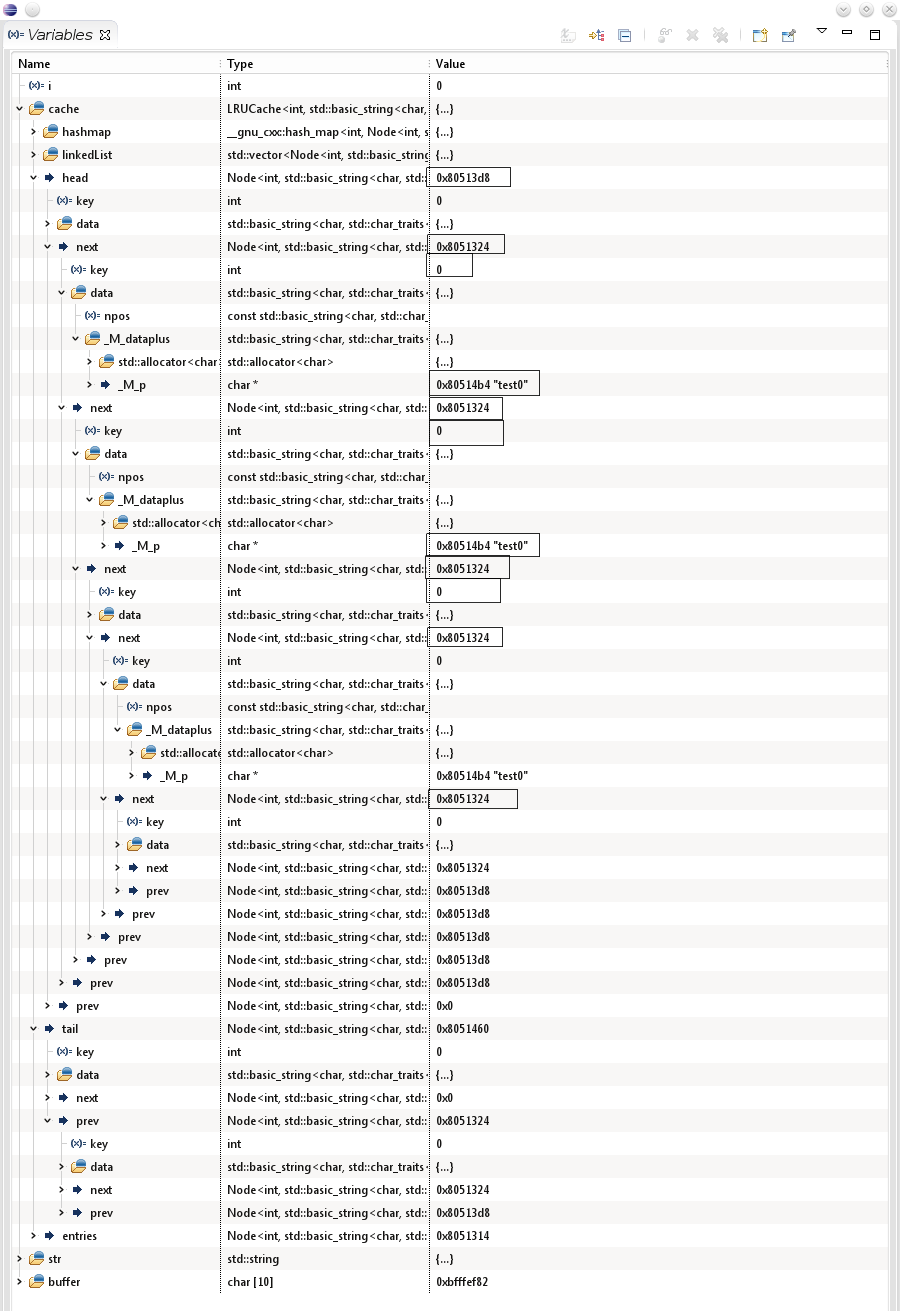
坑爹了,全部节点的next指针全部都指向自己,这样的话链表长得像什么样子呢?应该是这样:

这个错误到底是怎么来的?
我反复地看代码,节点的链入(Attach)和取出(Detach)都是没有问题的,而且,插入新节点的时候,已经插入过的节点为什么没有了?Attach方法既然是正确的,那为什么节点的next为什么会指向自己?
综合上面两个问题,我突然意识到:那只能是分配地址的时候出现问题了!
所以回到构造函数分配地址的部分,我发现在for循环里面,本应是:
linkedList.push_back(entries+i);
这样就能顺序存储分配好的地址。
但我竟然把i写成了1,所以每个地址都成了同一个!吐血的经历。
最后代码更正之后即可正确运行:
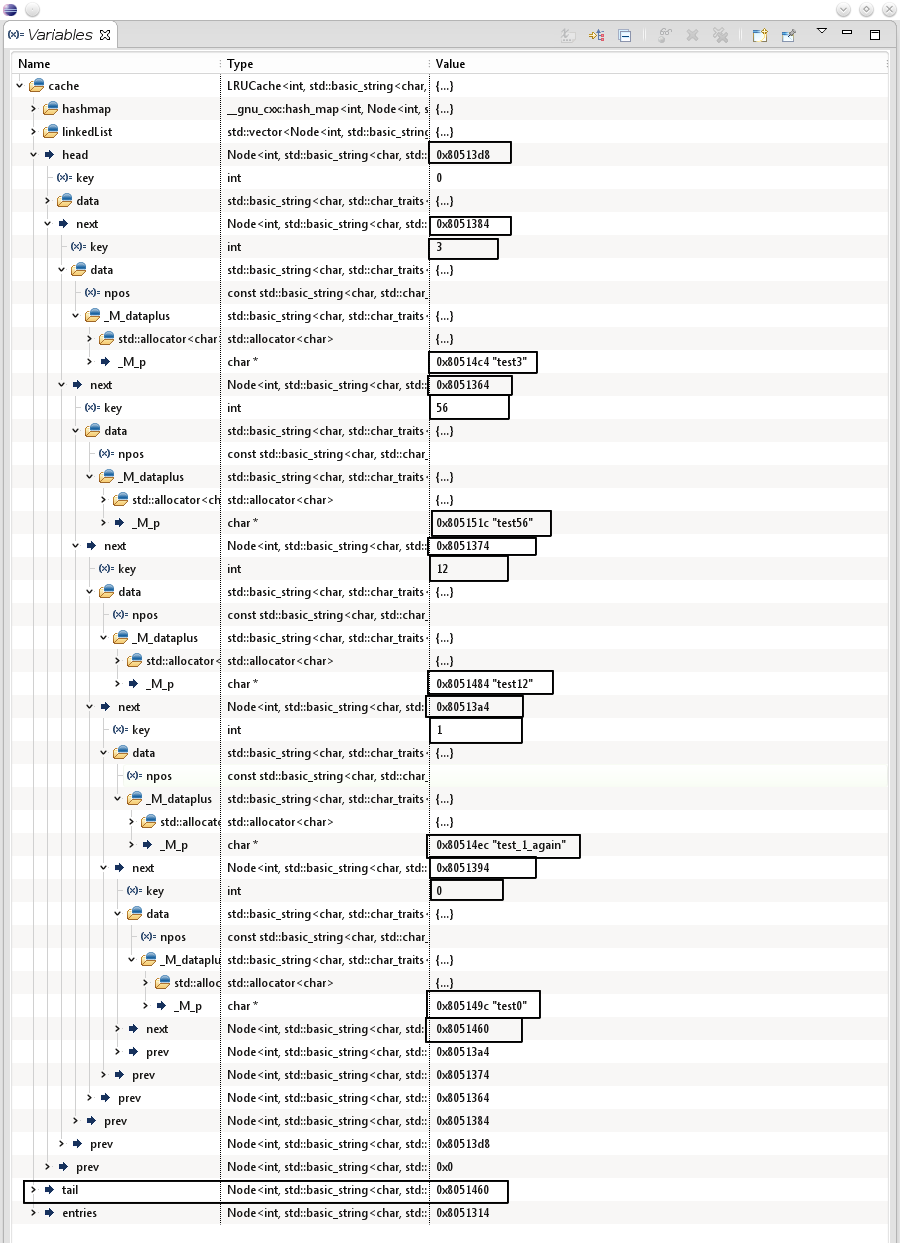
对应的测试代码为:
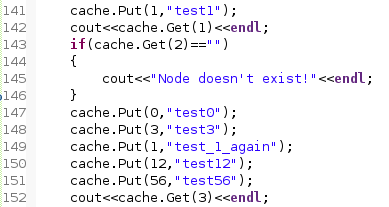
最后一笔带过编写过程中遇到的三个主要问题:
1、make install 源码包安装的软件怎么卸载(最好用--prefix=""指定安装路径,这样你卸载的时候直接卸载那个安装路径的文件夹);
2、QtCreator调试的时候为什么不显示变量(因为你用的python版本是3.0以上的,Qt的gdb调试器不支持,自己重新装一个2.X版本的,参考链接:http://blog.hostilefork.com/qtcreator-debugger-no-locals-ubuntu/);
3、测试代码的时候出现一点小错误,搞了很久但还是不知道为什么(在main函数中注释的最后一段代码,有兴趣的可以自己调试一下)。
参考文章:
1、http://www.cs.uml.edu/~jlu1/doc/codes/lruCache.html
2、http://blog.csdn.net/xiaofei_hah0000/article/details/8993617
